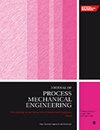带热管的蒸汽压缩制冷循环的实验分析
IF 2.2
4区 工程技术
Q2 ENGINEERING, MECHANICAL
Proceedings of the Institution of Mechanical Engineers, Part E: Journal of Process Mechanical Engineering
Pub Date : 2024-08-22
DOI:10.1177/09544089241272837
引用次数: 0
摘要
本研究的重点是将热虹吸式环形热管集成到蒸汽压缩制冷循环中,以运行制冷量为 20 千瓦的起重机机舱空调。热管的蒸发器与蒸汽压缩循环的压缩机出口和冷凝器入口之间的管路相连。此外,热管的冷凝器位于现有冷凝器的上方。热管从压缩机排出的热 R450A 制冷剂中提取热量,降低制冷剂的温度,从而减轻现有系统冷凝器的部分负荷。冷凝器负荷的减少降低了饱和温度。实验研究了热管对起重机空调系统的影响。当热导管启动时,系统中的冷凝温度会根据环境温度进行调整,从而彻底检查热导管对系统的影响。研究结果表明,在相同的运行条件下,热管情况下的制冷量和 COP 值都有所增加。此外,使用热管时,向环境排放的二氧化碳也更少。通过在蒸汽压缩制冷系统中使用热管,可以减少能耗排放,提高能效。本文章由计算机程序翻译,如有差异,请以英文原文为准。
Experimental analysis of a vapor compression refrigeration cycle with heat pipe
This study focuses on the integration of a thermosyphon-type loop heat pipe into a vapor compression refrigeration cycle that operates a crane cabin air conditioner with a refrigeration capacity of 20 kW. The evaporator of the heat pipe is incorporated into the line between the compressor outlet and the condenser inlet of the vapor compression cycle. In addition, the condenser of the heat pipe is placed above the existing condenser. The heat pipe extracts heat from the hot R450A refrigerant exiting the compressor, reducing the refrigerant's temperature and, consequently, alleviating a portion of the condenser load from the existing system. Decreased load on the condenser reduces the saturation temperature. The impact of the heat pipe on the crane's air conditioning system was experimentally investigated. When the heat pipe is activated, the condensation temperature in the system is adjusted on the basis of the ambient temperature, allowing for a thorough examination of the heat pipe's effects on the system. According to the results of this study, it was concluded that the refrigeration capacity and COP values increased in the heat pipe case under the same operating conditions. In addition, when using a heat pipe, there are fewer CO2 emissions released into the environment. It is possible to reduce emissions from energy consumption and increase energy efficiency by using a heat pipe in the vapor compression refrigeration system.
求助全文
通过发布文献求助,成功后即可免费获取论文全文。
去求助
来源期刊
CiteScore
3.80
自引率
16.70%
发文量
370
审稿时长
6 months
期刊介绍:
The Journal of Process Mechanical Engineering publishes high-quality, peer-reviewed papers covering a broad area of mechanical engineering activities associated with the design and operation of process equipment.

 求助内容:
求助内容: 应助结果提醒方式:
应助结果提醒方式:


